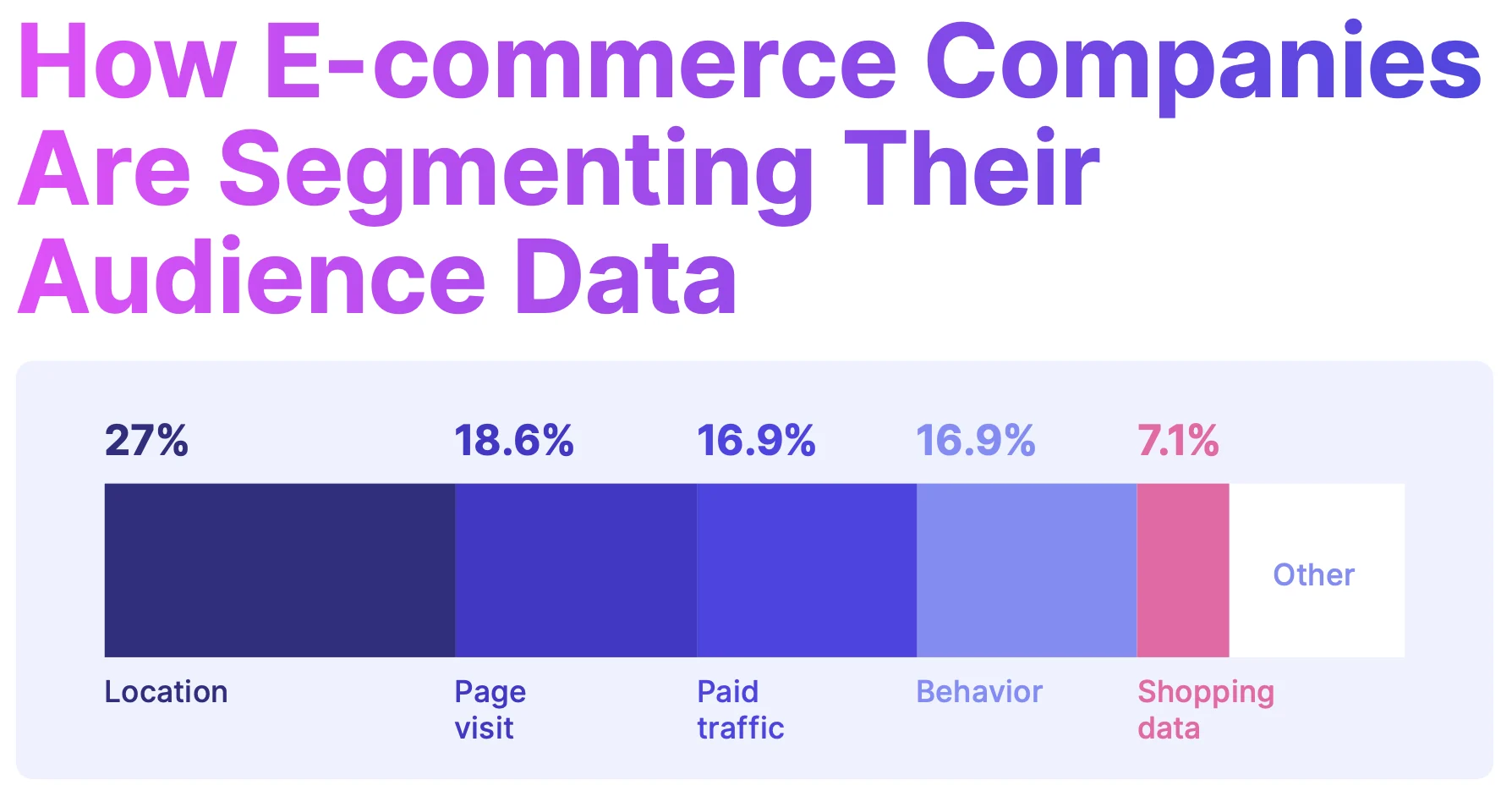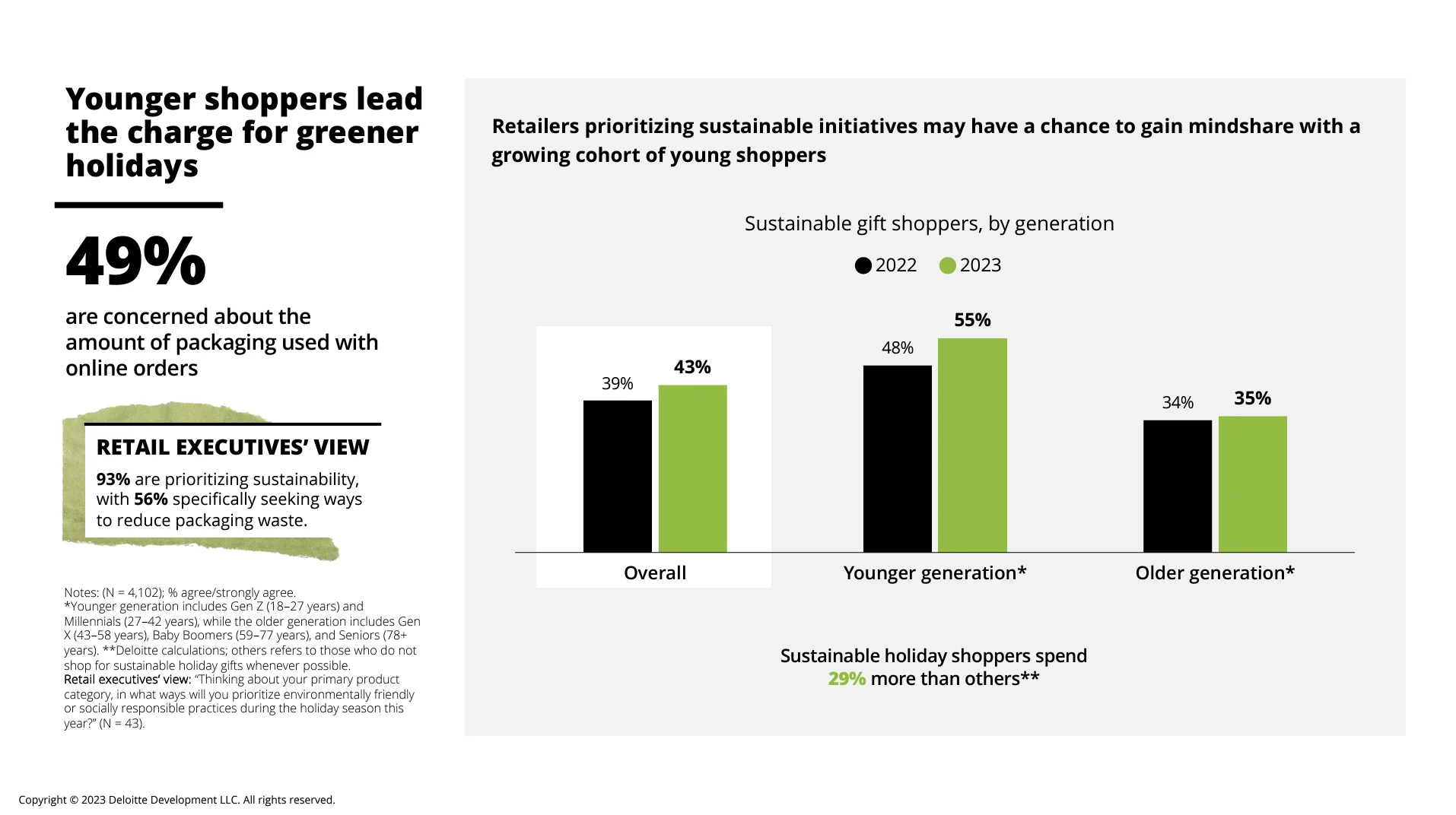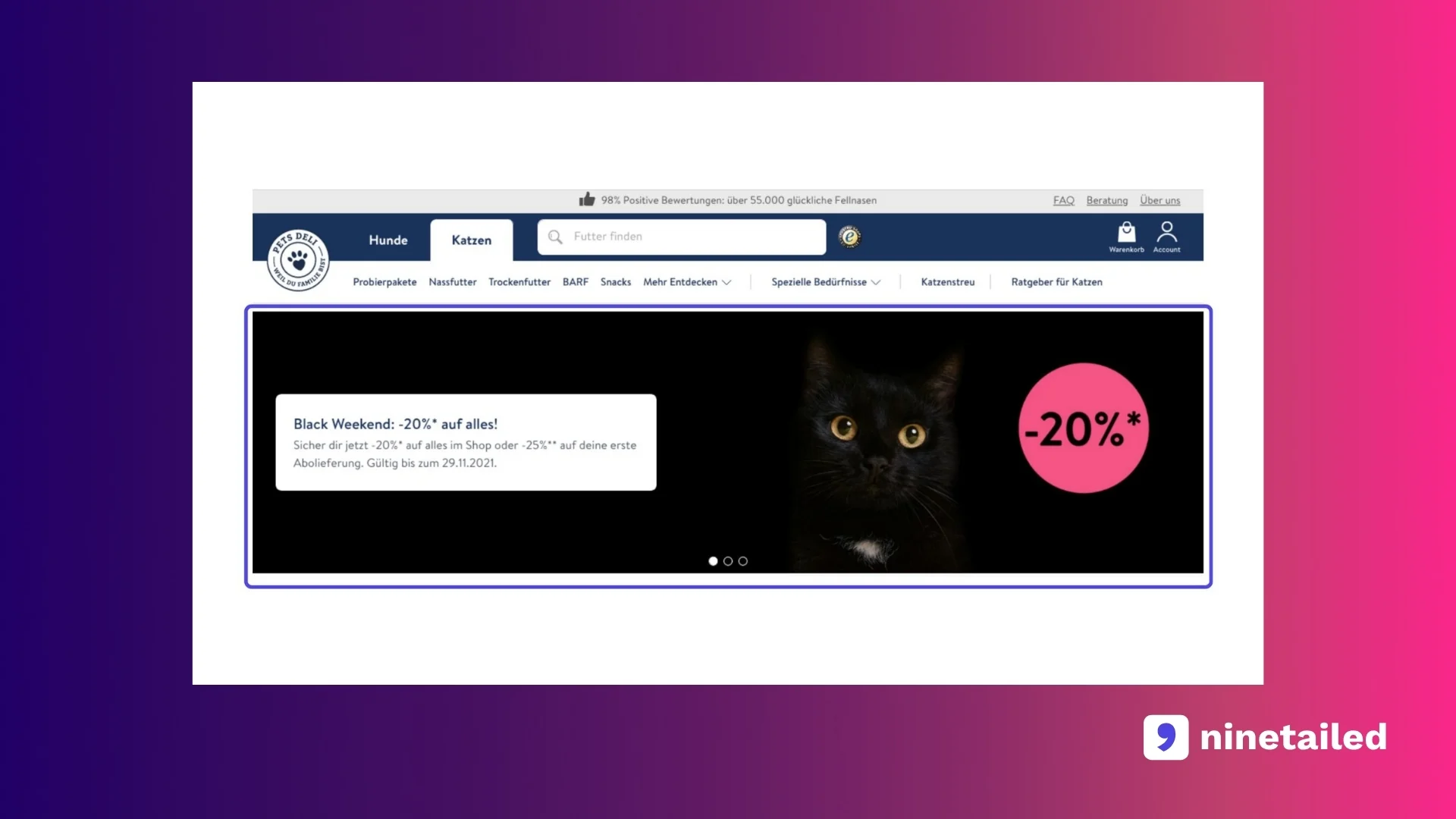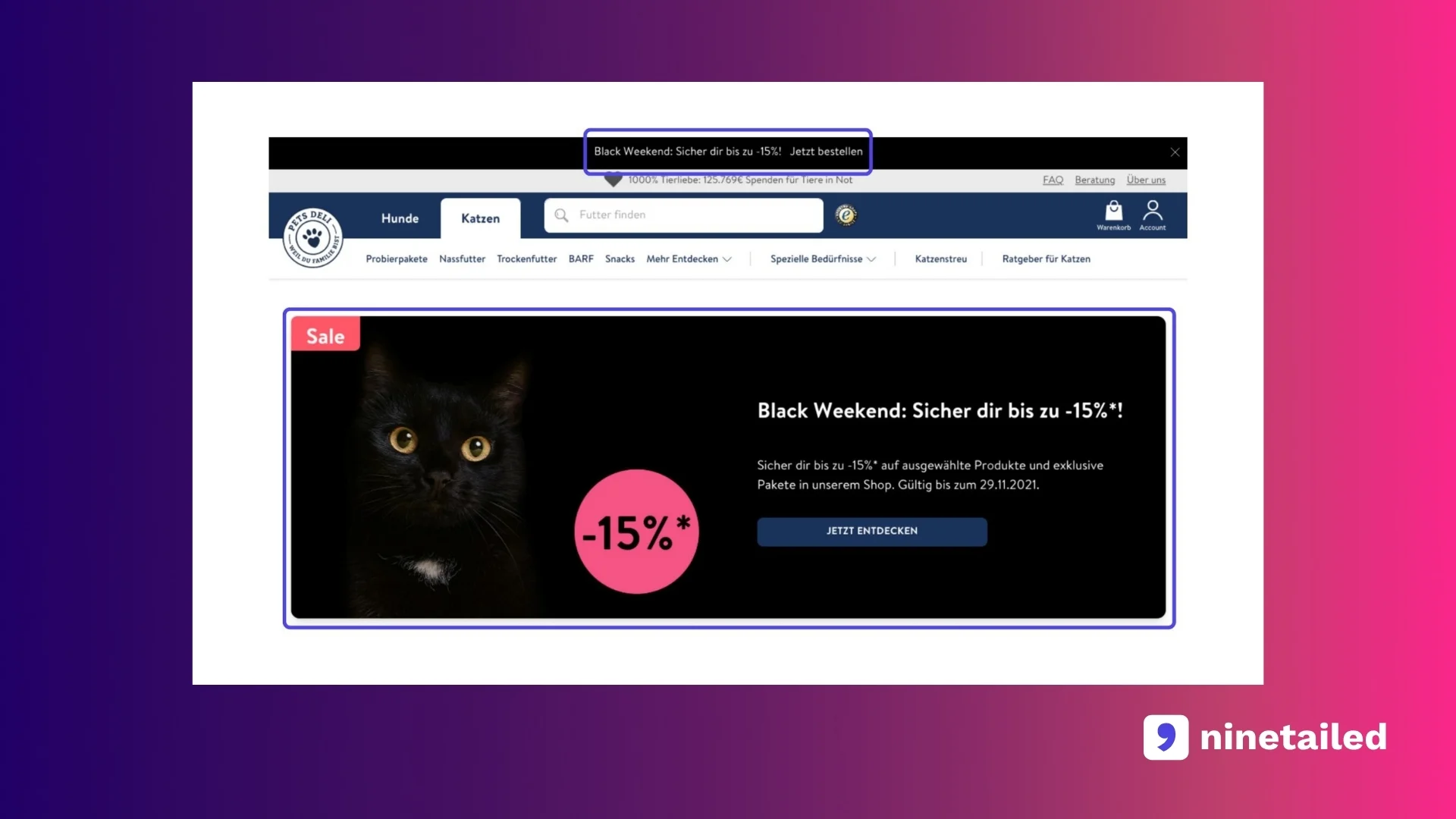- Commerce
5 Black Friday Trends That Will Shape the 2024 Holiday Season


Holiday sales have been growing at an unprecedented rate, with total spending increasing from $437.6 billion in 2003 to a staggering $964.4 billion in 2023.

This remarkable growth represents a massive opportunity for brands to capitalize on the ever-expanding holiday shopping season.
To capture the maximum potential, it's crucial for businesses to stay informed about recent trends, evolving consumer behaviors, and technological advancements that are shaping the landscape. The following are five key Black Friday trends we’re seeing from our customers and partners that will define the 2024 holiday season and help retailers optimize their strategies for success.
1. AI
We all know AI is everywhere and everything we do.
AI is set to continue transforming Black Friday in 2024 as well, making shopping smarter and more personalized. Here are three key ways AI will shape this year's holiday season:
Predictive Analytics
AI is getting better at predicting what customers might need or want next. By analyzing past purchases and browsing behavior, AI can suggest products that shoppers are likely to buy. This means businesses can:
Improve cross-selling and upselling opportunities
Offer personalized recommendations
Enhance the overall shopping experience
For example, if you bought a camera last month, AI might suggest accessories like tripods or memory cards during Black Friday sales.
Sentiment Analysis
Understanding customer feelings is crucial for any business. AI will play a significant role in gauging customer sentiment from social media, reviews, and feedback. This helps businesses to:
Address customer complaints quickly
Capitalize on positive feedback
Tailor marketing strategies to match customer moods
Imagine knowing exactly how your customers feel about your latest product and being able to respond in real-time. That's the power of AI-driven sentiment analysis.
Advanced Segmentation
Gone are the days of broad audience targeting. With AI, businesses can now create more detailed audience segments. By leveraging big data and machine learning, companies can:
Target users based on browsing history
Personalize offers based on purchase history
Tailor marketing efforts based on behavioral data
Between the crowded market, stricter data privacy regulations, and a decline in paid ad performance, e-commerce companies are rethinking their marketing strategies. For most, this has led to a greater focus on personalization.
Here’s how they’re breaking up their audiences:

As marketers who got into personalization to better connect with customers, we were curious about how people use our platform to connect with theirs.
To help other marketers better segment their audiences, we dove into data on thousands of Ninetailed experiences. This allowed us to uncover how Ninetailed power users segment their audiences.
This report presents our findings, split by our users' three biggest industries: e-commerce, SaaS, and financial services. Here’s what we found:
2. Buy Now, Pay Later (BNPL)
With more consumers looking for flexible payment options, BNPL is becoming a popular choice for budget-conscious shoppers.

Here’s why BNPL will be a major trend shaping the 2024 holiday season:
Flexible Payment Options
BNPL services allow shoppers to make purchases without immediate financial strain. Instead of paying the full amount upfront, consumers can split their payments into manageable installments. This has several benefits:
Eases financial pressure: Shoppers can spread out their expenses, making it easier to afford big-ticket items.
Increases purchasing power: Consumers are more likely to buy higher-priced products when they don’t have to pay all at once.
Attracts more customers: Retailers offering BNPL options can appeal to a wider audience, including those who might not have the funds to pay in full upfront.
Increased Adoption
Both online and brick-and-mortar stores are integrating BNPL options to attract shoppers. This widespread adoption is making it easier than ever for consumers to use BNPL services, regardless of where they shop. Key statistics highlight the growing trend:
Record usage during the holiday season: In 2022, BNPL usage hit an all-time high, contributing $16.6 billion in online spending, up 14% year-over-year (YoY).
November surge: November 2022 saw the biggest month on record for BNPL, with $9.2 billion in spending, up 17.5% YoY. Cyber Monday alone accounted for $940 million, up 42.5% YoY.
These numbers show that more shoppers are turning to BNPL to manage their holiday spending.
BNPL services are set to play a significant role in Black Friday 2024. By offering flexible payment options and being widely adopted across various shopping platforms, BNPL is making shopping more accessible and appealing to a broader audience.
This trend not only benefits consumers but also helps retailers boost their sales and attract more customers.
3. Sustainability and Ethical Shopping
As the world becomes more environmentally conscious, sustainability is set to be a major trend this Black Friday. Shoppers are increasingly looking for ways to make their purchases more eco-friendly and ethically responsible. Here’s how sustainability will shape the 2024 holiday season:
Eco-Friendly Products
More consumers are showing a growing preference for sustainable and ethically sourced products. This trend is driven by a desire to reduce environmental impact and support businesses that prioritize ethical practices. Key highlights include:
Demand for eco-friendly materials: Shoppers are looking for products made from recycled or sustainable materials.
Preference for ethical brands: Consumers are choosing brands that demonstrate a commitment to fair labor practices and environmentally friendly manufacturing processes.
Reduced packaging: With 49% of young shoppers concerned about the amount of packaging used with online orders, retailers are adopting more sustainable packaging solutions.

Green Friday Campaigns
In addition to offering eco-friendly products, some retailers are promoting "Green Friday" initiatives. These campaigns encourage environmentally friendly shopping habits and raise awareness about sustainable practices. Examples include:
Promoting second-hand items: Encouraging shoppers to buy pre-owned or refurbished products.
Highlighting sustainable brands: Featuring products from companies with strong environmental credentials.
Offering eco-friendly incentives: Providing discounts or perks for customers who choose greener options.
For example, a retailer might offer a discount on a new item if you bring in an old one to be recycled.
According to Deloitte, sustainable holiday shoppers spend 29% more than others. This shows that consumers are willing to invest more in products that align with their values, making sustainability not only good for the planet but also beneficial for businesses.
4. Omnichannel Experiences (and the Rise of Composable Technologies)
As Black Friday 2024 approaches, omnichannel experiences are set to be a significant trend, seamlessly connecting the dots between online and offline shopping. Here’s how retailers are enhancing the shopping journey to meet the evolving needs of consumers.
Physical stores are focusing on providing unique experiences that cannot be replicated online. By offering exclusive in-store promotions and events, retailers are making a trip to the store worthwhile. Key elements include:
Exclusive promotions: Special deals and discounts are available only in-store.
Interactive events: In-store demonstrations, workshops, and meet-and-greet sessions with influencers or brand ambassadors.
Personalized services: Tailored shopping assistance, product customization, and in-store pickup for online orders.
Retailers are enhancing the shopping experience by offering seamless integration across online and offline channels. This is achieved through composable technologies that ensure a smooth transition between different platforms. Key strategies include:
Unified experiences: Allowing customers to add items to their cart from any device and complete the purchase anywhere.
Consistent promotions and experiences: Offering the same deals and discounts across all channels to avoid confusion and frustration.
According to McKinsey, most consumers plan to do their holiday shopping research using retailer websites or apps and by browsing in-store. This underscores the importance of a strong omnichannel experience. Social media also plays a crucial role, especially for Gen Z and millennials, as a discovery channel for new products and deals.

Despite the ongoing shift toward online shopping, the physical store experience still matters. McKinsey’s data shows that 85 percent of consumers expect to purchase at least one item in-store, while 12 percent plan to pick up purchases in-store. This highlights the need for retailers to maintain a robust in-store presence while enhancing their online offerings.
5. Personalization (and AI, again)
Personalization will be a key trend, ensuring that every shopper feels like the star of their own holiday shopping journey. By leveraging AI and dynamic content, retailers can provide highly individualized experiences that cater to unique preferences and needs.
Websites will feature dynamic content that changes in real-time to reflect individual user preferences. This means that when you visit a retailer’s website, you’ll see:
Personalized homepages: Your homepage will highlight products and deals based on your browsing history, past purchases, the campaigns you’re coming from, your location, etc.
Tailored product suggestions: Recommendations will be curated just for you, showing items you’re most likely to be interested in.
Customized promotions: Special offers and discounts that are relevant to your shopping habits and preferences.
Data shows that marketing investments drove large sales volumes for retailers across the season:
Paid search: 29.4% of online sales
Direct web visits: 19.3% of online sales
Affiliates and partners: 16.6% of online sales
Organic search: 15.9% of online sales
Email: 15.3% of online sales
Social media: 3.5% of online sales
Budget isn't your only lever to drive more sales. Retailers can convert more visitors by personalizing the experience for every campaign. Here’s how:
Paid Traffic Personalization
When visitors land on a webpage via paid advertisements, they often encounter a jarring disconnect.
The messaging on the landing page frequently deviates from the ad copy that brought them there. This mismatch creates a disjointed user experience, potentially deterring the visitor from exploring further or making a purchase.
Our customers' experiences have reinforced this theory time and again. When an ad's content aligns perfectly with the content of the landing page it leads to, the conversion rate invariably increases. This is the power of message matching – it bridges the gap between advertisement and landing page, creating a seamless and satisfying user experience.
Message matching doesn't require you to increase your ad spend.
Rather, it focuses on optimizing the existing resources to deliver a more impactful, personalized experiences.
Before jumping to the details, here's how Ruggable leveraging this strategy to showcase personalized experiences based on paid campaigns with Ninetailed:
Ruggable, an innovative interior brand known for its patented 2-piece rugs, took personalization to a new level by creating two distinct experiences on its website.
Ruggable recognized that their customer base comprised two primary segments — dog owners and cat owners. They decided to capitalize on this insight by launching two separate paid campaigns targeting each group. However, they didn't stop at just targeted ad content. They extended this personalization strategy right through to their website.
Dog-Related Campaigns: Visitors who landed on Ruggable's website via dog-related paid campaigns were greeted with dog-centric content. This could include images of dogs enjoying Ruggable's rugs, testimonials from dog-owning customers, or even a special collection of rugs ideal for households with dogs. This tailored experience resonated strongly with dog owners, making them feel understood and catered to.
Cat-Related Campaigns: Similarly, visitors arriving from cat-related paid campaigns were met with a plethora of cat-related content. This might encompass pictures of cats lounging on Ruggable's rugs, reviews from cat-parent customers, or a curated selection of rugs perfect for feline-friendly homes. This personalized experience appealed to cat owners, reinforcing the brand's understanding of their unique needs.

By matching the ad message to the landing page experience, Ruggable created a seamless journey for their customers.
The result?
increase in conversion rate by 25%
click-through rate jump by 7 times
decrease in personalization creation time from 2 days to 30 minutes
This example demonstrates the profound impact of personalization, particularly when it's consistently applied across the customer journey, from paid ads to landing pages.
Email Campaign and SMS Traffic Personalization
Imagine sending out an email or SMS campaign and having the ability to tailor the entire user experience from that point onward.
Just like with paid traffic personalization, leveraging UTM parameters allows organizations to craft unique, personalized experiences for visitors arriving from different email and SMS campaigns.
This means that whether a customer clicks on a link from an email about special Black Friday sales or an SMS about a flash discount, they’ll land on a page that speaks directly to their interests and needs.
This seamless, personalized journey not only enhances user engagement but also drives higher conversion rates, making every campaign feel like a bespoke shopping experience.
Loyalty Personalization
Every interaction on your site is an opportunity to convert a visitor into a customer. By tailoring the user experience based on individual behaviors, you're not just showing your audience that you understand them, but also making the path to conversion smoother and more compelling.
Pets Deli, a market leader in the European Direct-to-Consumer (D2C) pet food industry, recognized the power of personalization and took a strategic approach towards it.
They did not just offer a generic experience to all their website visitors. Instead, they meticulously analyzed their customers' past purchasing behavior and identified distinct customer segments. The brilliance of their strategy did not stop there.
For each customer segment, Pets Deli created a unique set of prices and promotions — ones that resonated with the specific needs and preferences of that group. This wasn't about random price variations or promotional offers. This was about understanding what their customers valued and tailoring their offerings accordingly.
The result? A 51% increase in conversion rates!
By offering personalized experiences that appeal to their customers' unique needs, Pets Deli not only enhanced their customers' shopping experience but also significantly boosted their bottom line.
Want More Personalization and A/B Testing Ideas?
Our comprehensive "27 A/B Testing Ideas" ebook is packed full of insightful tips, innovative ideas, and practical examples to help you take your A/B testing to the next level. Whether you're new to the world of A/B testing or an experienced marketer looking to sharpen your skills, this ebook is a must-read.
So why wait?
Supercharge your marketing strategy and boost your conversion rates today by downloading your free copy of our "27 A/B Testing Ideas" ebook!



